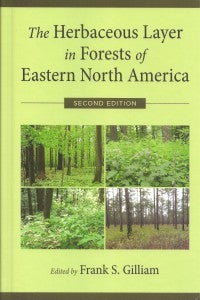
Monday, Feb. 17, 2014
[social_share/]HUNTINGTON, W.Va. – Marshall University biology professor Dr. Frank S. Gilliam has published his third book, “The Herbaceous Layer in Forests of Eastern North America, Second Edition.” Oxford University Press released the volume this week.
A recognized expert in plant ecology, Gilliam studies the movement and cycling of plant nutrients within land-based, or terrestrial, ecosystems.
He describes the herbaceous layer as the lowest layer of plants in the forest.
“This layer is generally less than one meter in height and includes a mixture of herbaceous species such as lilies and grasses, along with seedlings of shrubs and trees,” he said. “Despite a growing awareness that the herbaceous layer serves a special role in maintaining the structure and function of forests, this stratum remains an underappreciated aspect of forest ecosystems. In fact, studies show the herb layer has a significance that belies its diminutive stature.”
The first edition of the book, co-edited by Gilliam and Mark R. Roberts, was published in 2003. That edition was praised for containing the most extensive listing of herb-layer literature in existence.
 Gilliam said this second edition brings the material up to date with current research, data and concepts. Also featured are eight entirely new chapters, with six of these focused on the response of the herbaceous layer to a wide variety of natural and human-caused disturbances.
Gilliam said this second edition brings the material up to date with current research, data and concepts. Also featured are eight entirely new chapters, with six of these focused on the response of the herbaceous layer to a wide variety of natural and human-caused disturbances.
He added that the book brings together research of top ecologists from a number of institutions, including Duke University, Harvard University, Wake Forest University, University of North Carolina, University of Georgia, University of Pittsburgh and Smith College, and that it should be a valuable resource not only for plant ecologists but also for forest ecologists, conservationists and forest managers.
“Over the last decade, the field of plant ecology has rapidly and substantially developed and expanded, especially in research concerning the herbaceous layer and ground vegetation of forests,” he said. “This second edition of the book summarizes and synthesizes that growth, presenting research that approaches the ecology of the herb layer of forests from a variety of disciplines, perspectives and levels of ecological organization.”
In addition to his role as editor for the entire volume, Gilliam is the author or co-author of six of the book’s 22 chapters.
He said the cover of the book depicts the herbaceous layer in four forests of eastern North America and includes one photo of the Nature Trail woods behind the Huntington Museum of Art.
Gilliam has been on the Marshall faculty since 1990 and teaches courses in introductory biology, ecology and plant ecology. He received his Ph.D. at Duke University before doing post-doctoral research at Kansas State University and the University of Virginia. Prior to coming to Marshall, he taught at the University of North Carolina at Greensboro.
In addition to the first two editions of this book, Gilliam is co-author of a textbook, “Terrestrial Plant Ecology, Third Edition,” which he uses in his plant ecology course at Marshall. He also has published nearly 30 book chapters and nearly 60 articles in the peer-reviewed ecological literature.
According to its website, Oxford University Press is the world’s largest university press.
Contact: Ginny Painter, Communications Director, Marshall University Research Corporation, 304.746.1964
